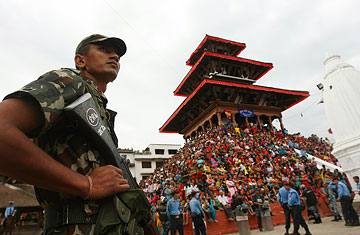
Nepalese soldiers stand guard at the Indra Jatra festival in Kathmandu's Durbar Square on Sept. 22, 2010
It was during Indra Jatra, the festival that marks the end of monsoon and honors the rain god Indra, that Prithvinarayan Shah attacked a bowl-shaped valley and expanded his kingdom to form what would eventually become modern-day Nepal. That was 1768, and in keeping with the local custom of the now-famous Nepali institution of Kumari — the worshipping of young girls believed to be incarnations of the Hindu deity Taleju — the new king went on to get blessings from the living goddess.
The last king of Shah's dynasty, however, wasn't as lucky. Last month, the site of the yearly celebration of Indra Jatra in Kathmandu's ancient Durbar Square became the latest frontline in a battle being waged between Nepal's ousted king and the nation's young government. When former king Gyanendra Shah, who left his post after the government voted to become a republic on May 28, 2008, attempted to pay homage to nine former royal Kumaris in the square, government supporters gathered to protest the former king's visit, and he was physically prevented from his visit. The government cited security reasons for the interruption, but one local news commentator said that the tussle amounted to nothing less than a battle between the old and new Nepal.
Nepal's transition out of monarchic rule has never been smooth. Five years ago, pro-democracy parties and the Maoists who had waged a decade-long war that claimed the lives of over 13,000 people, signed a deal in India to join their efforts to overthrow Nepal's centuries-old monarchy. With the mounting pressure from ensuing street protests and the international community, Gyanendra stepped down on April 24, 2006 and reinstituted the parliament that he had dissolved four years earlier. For many, it was a long-awaited victory, but it was not until two years after the popular protest that Nepal's last king was booted out of the royal palace in Kathmandu.
But many lingering issues — key among them the still-unfinished constitution and the integration of 19,000 former Maoist combatants who are sequestered in U.N.-monitored camps across the country — have prevented the new government from pushing through reforms it had promised upon its formation. The peace process between the seven parliamentary parties and the Maoists, which looked promising until the Maoist Prime Minister Pushpa Kamal Dahal, better known by his nom de guerre Prachanda, resigned from the government a year ago, is unraveling as continuous bickering within the government has thrown the country into disarray. Since Prime Minister Madhav Kumar Nepal resigned on June 30 under pressure from the Maoists, the country has failed to elect a Prime Minister even after elections on Oct. 10.
That political limbo has locked the nation of 28 million into a state of perennial dysfunction — and created a wave of support for the former monarch. Last month's festival is not the first time the former king has tried to get back in the spotlight. He's been relentlessly shadowing President Ram Baran Yadav, who has replaced the former king as the ceremonial head of the state, in an effort to gain back the popularity that he lost. In March, Gyanendra's visit to the Ram Janaki temple, believed to be the birthplace of Sita, the wife of Hindu god Ram, forced Yadav to reschedule his own visit there to avoid an awkward encounter. The same day, Gyanendra gave his first interview to a local television station since losing the throne. He said the question of monarchy's end was "hypothetical."
The comment triggered an avalanche of press, culminating in the prime minister saying that Gyanendra was "daydreaming" — a surprising display of disrespect to the former monarch. "There's no chance of reverting back to the monarchical system," says Surya Dhungel, a constitutional adviser to the president. "The former king, as well as all the former royals, have to choose between the erstwhile privilege and the rights of the citizens" to choose their government.
But the opposition, including the National Democratic Party, questions the fundamental changes — from monarchy to republic, from Hindu to secular — made by Maoists and their coalition partners in past four years. Kamal Thapa, the home minister during the former king's rule and head of a royalist splinter group, has been demanding a referendum be held on the issue of reinstating the monarchy. According to opinion polls conducted in 2007 by Kathmandu-based research group Interdisciplinary Analysts, 50% of the respondents were in favor of some form of monarchy. "Monarchy may be past, but the king is not," says Sudhindra Sharma, a leading sociologist with the research group. "Once the king, he will forever be the king." According to Sharma, the best way out of the current tumult would be for President Yadav to act as the head of state while the king should be allowed to attend and perform some Hindu ceremonies in keeping with the monarch's traditional role as the nation's religious leader. "There are certain rituals that only the king can do," Sharma says.
Meanwhile, many Nepalis are frustrated with the political parties' failure to deliver anything that resembles a functioning government. Parasar Rijal, 52, who runs a stationery store in the capital's Bagbazaar neighborhood, says, "The parties have not only betrayed our aspirations, but have also stooped very low."
